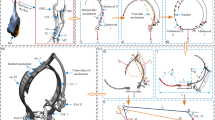Abstract
The present study develops a safety survey system for measuring natural river discharge. Monitoring of rivers is very important for river environment conservation and flood prevention. The new system is a drone-type float with a Global Positioning System (GPS) receiver, which can safely and quickly monitor a river. This float flies to the target point on a free surface according to the operator’s control. After which, it runs freely downstream, detecting the time-series of self-position with a centimeter-order accuracy using the real-time kinetic GPS method. It also measures the local water depth using an ultrasonic sensor during the drifting downstream. The same works are repeatedly conducted on all survey lines to evaluate the discharge through a target cross-section. The data correction formula considering the wind effects is introduced to improve the measurement accuracy. We performed field tests in natural rivers and obtained reliable results for practical application. The present system can evaluate the discharge in a 250 m width large-scale river without using an observation bridge or a rubber boat.
Highlights
-
1.
Safe and quick measurements of surface velocity and discharge in rivers becomes possible using a drone-type float.
-
2.
Reliable river surface survey can be performed by consideration of wind effects on float velocity.
-
3.
The present portable instrumentation has a practical advantage in safe and remote river survey.












Similar content being viewed by others
References
Ngoma DH, Wang Y (2018) Hhaynu micro hydropower scheme: Mbulu–Tanzania comparative river flow velocity and discharge measurement methods. Flow Meas Instrum 62:135–142
Fujita I, Muste M, Kruger A (1998) Large-scale particle image velocimetry for flow analysis in hydraulic engineering applications. J Hydraulic Res 36(3):397–414
Fujita I, Notoya Y, Tani K, Tateguchi S (2019) Efficient and accurate estimation of water surface velocity in STIV. Environ Fluid Mech 19:1363–1378
Muste M, Yu K, Spasojevic M (2004) Practical aspects of ADCP data use for quantification of mean river flow characteristics; part I: moving-vessel measurements. Flow Meas Instrum 15(1):1–16
García CM, Oberg K, García MH (2007) ADCP measurements of gravity currents in the Chicago River, Illinois. J Hydraulic Eng 133(12):1356–1366
Konsoer KM, Rhoads BI (2014) Spatial-temporal structure of mixing interface turbulence at two large river confluences. Environ Fluid Mech 14:1043–1070
Tauro F, Pagano C, Phamduy P, Grimaldi S, Porfiri M (2015) Large-scale particle image velocimetry from an unmanned aerial vehicle. IEEE/ASME Trans Mech 20(6):1–7
Perks MT, Russell AJ, Largem ARG (2016) Technical notes: advances in flash flood monitoring using unmanned aerial vehicles (UAVs). Hydrol Earth Syst Sci 20(10):4005–4015
Tauro F, Petroselli A, Arcangeletti E (2016) Assessment of drone-based surface flow observations. Hydrol Process 30(7):1114–1130
Koutalakis P, Tzoraki O, Zaimes G (2019) UAVs for hydrologic scopes: application of a low-coat UAV to estimate surface water velocity by using three different image-based methods. Drone 3(1):14
Strelnikova D, Paulus G, Kafer S, Anders KH, Mayr P, Mader H, Scherling U, Schneeberger R (2020) Drone-based optical measurements of heterogeneous surface velocity fields around fish passages at hydropower dams. Remote Sens 12(3):384
Pearce S, Ljubicic R, Pena-Haro S, Perks M, Tauro F, Pizarro A, Dal Sasso SF, Strelnikova D, Grimaldi S, Maddock I, Paulus G, Plavsic J, Prodanovic D, Manfreda S (2020) An evaluation of image velocimetry techniques under low flow conditions and high seeding densities using unmanned aerial systems. Remote Sens 12(2):232
Liu WC, Lu CH, Huang WC (2021) Large-scale particle image velocimetry to measure streamflow from videos recorded from unmanned aerial vehicle and fixed imaging system. Remote Sens 13:2661
Sanjou M, Nagasaka T (2017) Development of autonomous boat-type robot for automated velocity measurement in straight natural river. Water Resour Res 53(11):9089–9105
Sanjou M, Shigeta A, Kato K, Aizawa W (2021) Portable unmanned surface vehicle that automatically measures flow velocity and direction in rivers. Flow Meas Instrum 80:101964
Tazioli A (2011) Experimental methods for river discharge measurements: comparison among tracers and current meter. Hydrol Sci J 56(7):1314–1324
Shin SS, Park SD, Lee SK (2016) Measurement of flow velocity using video image of spherical float. Procedia Eng 154:885–889
Shin S, Park S (2021) Application of spherical-rod float image velocimetry for evaluating high flow rate in mountain rivers. Flow Meas Instrum 78:101906
Ahn M, Yoon B, Ji U (2019) Uncertainty analysis for mean flow velocity and discharge measurements using floats based on large-scale experiments. KSCE J Civil Eng 23(8):3364–3371
Risio MD, Sammarco P (2020) Effects of floaters on the free surface profiles of river flows. Environ Fluid Mech 20:527–537
Sanjou M, Nezu I (2017) Fundamental study on mixing layer and horizontal circulation in open-channel flows with rectangular embayment zone. J Hydrodynamics 29(1):75–88
Genc O, Ardiclioglu M, Agiralioglu N (2015) Calculation of mean velocity and discharge using water surface velocity in small streams. Flow Meas Instrum 41:115–120
Sanjou M, Nezu I, Suzuke S, Itai K (2010) Turbulence structure of compound open-channel flows with one-line emergent vegetation. J Hydrodyn 22(1):560–564
Acknowledgements
The authors would like to thank the financial supports of the Research Project Grant-In-Aid for Scientific Research (C) of Japanese Government (No. 20K04704, Principle Investigator= M. Sanjou) and the Research Project Grant-In-Aid for Scientific Research (B) of Japanese Government (No.19H02249, Principle Investigator= Y. Sugihara). We appreciate English editing by Enago, and thank Mr. Kouki Yoshinaga for the great support in the field survey.
Author information
Authors and Affiliations
Corresponding author
Additional information
Publisher's Note
Springer Nature remains neutral with regard to jurisdictional claims in published maps and institutional affiliations.
Rights and permissions
About this article
Cite this article
Sanjou, M., Kato, K., Aizawa, W. et al. Development of drone-type float for surface-velocity measurement in rivers. Environ Fluid Mech 22, 955–969 (2022). https://doi.org/10.1007/s10652-022-09874-1
Received:
Accepted:
Published:
Issue Date:
DOI: https://doi.org/10.1007/s10652-022-09874-1




